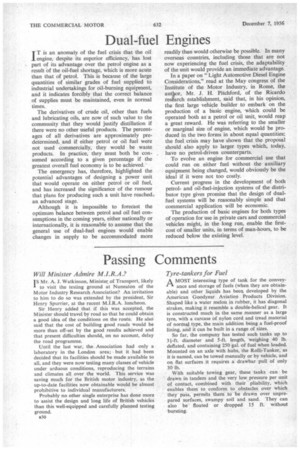Dual-fuel Engines
Page 38

If you've noticed an error in this article please click here to report it so we can fix it.
I T is an anomaly of the fuel crisis that the oil engine, despite its superior efficiency, has lost part of its advantage over the petrol engine as a result of the oil-fuel shortage, which is more acute than that of petrol. This is because of the large quantities of similar grades of fuel supplied to industrial undertakings for oil-burning equipment, and it indicates forcibly that the correct balance of supplies must be maintained, even in normal times.
The derivatives of crude oil, other than fuels and lubricating oils, are now of such value to the community that they would justify distillation if there were no other useful products. The percentages of all derivatives are approximately predetermined, and if either petrol or oil fuel were not used commercially, they would be waste products. In practice, they must both be consumed according to a given percentage if the greatest overall fuel economy is to be achieved.
The emergency has, therefore, highlighted the potential advantages of designing a power unit that would operate on either petrol or oil fuel, and has increased the significance of the rumour that plans for producing such a unit have reached an advanced stage.
Although it is impossible to forecast the optimum balance between petrol and oil fuel consumptions in the coming years, either nationally or internationally, it is reasonable to assume that the general use of dual-fuel engines would enable changes in supply to be accommodated more readily than would otherwise be possible. In many overseas countries, including those that are not now experiencing the fuel crisis, the adaptability of the unit would provide an immediate advantage..
In a paper on "Light Automotive Diesel Engine Considerations." read at the May congress of the Institute of the Motor Industry, in Rome, the author, Mr. J. H. Pitchford, of the Ricardo research establishment, said that, in his opinion, the first large vehicle builder to embark on the production of a basic engine, which could be operated both as a petrol or oil unit, would reap a great reward. He was referring to the smaller or marginal size of engine, which would be pro-, duced in the two forms in about equal quantities; the fuel crisis may have shown that the proposal should also apply to larger types which, today, have no petrol-driven counterparts.
To evolve an engine for commercial use that could run on either fuel without the auxiliary equipment being changed, would obviously be the ideal if it were not too costly.
Current progress in the development of both petroland oil-fuel-injection systems of the distributor type gives promise that the design of dual. fuel systems will be reasonably simple and that commercial application will be economic.
The production of basic engines for both types of operation for use in private cars and commercial vehicles might, in the long run, enable the firstcost of smaller units, in terms of man-hours, to be reduced below the existing level.




























































































































